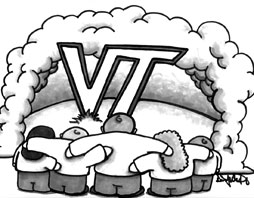By Sara Pintilie/reporter

An exhibit of real preserved bodies is at the Museum of Nature and Science in Dallas until May 28.
The Dallas exhibit, Body Worlds: An Anatomical Exhibition of Real Human Bodies, has more than 200 pieces, including about 15 full bodies or plastinates.
“ It is a rare opportunity to see what is normally kept hidden,” Noah Lauzon, an UNT student, said.
Among the full-body plastinates, individual organs in various states of health and body slices are also present.
“ I was interested in Body Worlds because I saw [the exhibit] in Casino Royale, and I find biology very interesting,” NE student Brent Humphrey said.
The Obesity Revealed piece is a side-view body slice of an obese man, showing the visitors the effects of obesity and the damage it causes on the internal organs.
“ I was just awed [by the exhibit], but I love anatomy,” Jill Pool, NE associate professor, physical therapist assistant program, said. “It was just amazing to see all that and not butchered like you sometimes see in cadaver films.”
In the exhibit, many of the pieces are not encased, so visitors can get a closer look.
“ I didn’t realize how close you can get to the pieces,” she said. “They didn’t have any barriers; you could almost touch them if no one was looking.”
The bodies are preserved by a process called plastination. The fluids and soluble fat is taken out and replaced with a reactive plastic. Then the plastinates are placed in everyday poses and cured to become rigid.
“ I am still developing my invention further, even today, as it is not yet perfect,” Von Hagens said in the Body Worlds press release.
Gunther Von Hagens invented plastination in 1977, and his Body Worlds exhibit premiered in 1995 in Japan. Body Worlds toured Asia and Europe in three separate exhibits until 2004. Currently, the three exhibits are traveling through North America.
Highlighted in the Dallas exhibit is The Smoker, a full-body male whose body has been damaged by smoking; The Tai Chi Man, a full-body male with surgical and orthopedic operations, and The Rearing Horse and Rider, a horse with a male rider with a human’s brain in one hand and a horse’s in the other.
“ Even if parents don’t explain the dangers of smoking educationally,” Lauzon said, “kids will be impacted by the smoker pieces in the exhibit.”

Despite the exhibit’s success, Body Worlds and plastination has raised ethical issues.
In 2004, the California Science Center reviewed the ethics of the exhibit.
“ The consensus of the Ethics Advisory Committee was that the exhibit has considerable educational value and is appropriate for the Science Center,” the review said.
The Science Center did state the body needs to be properly donated with the right credentials.
“ None [of the possible ethical issues] truly bothered me,” Humphrey said. “However, several people were quite distressed about an eight-and-a-half-month pregnant woman.”
Along with Reclining Pregnant Woman, fetuses from various stages of pregnancy are also in the Dallas exhibit.
“ [The exhibit] is so well done, I just don’t see the problem people have with the exhibit.” Pool said. “It’s not gaudy. It is scientifically artistic; it’s beautiful.”
EXHIBIT FACTS
Viewed by more the 20 million people
Audio Tours are available
Exhibit also features an “I quit” box where visitors can pledge to quit smoking and throw their cigarettes away
An IMAX film, The Human Body, is also at the Museum
More information: www.natureandscience.org/bodyworlds/























